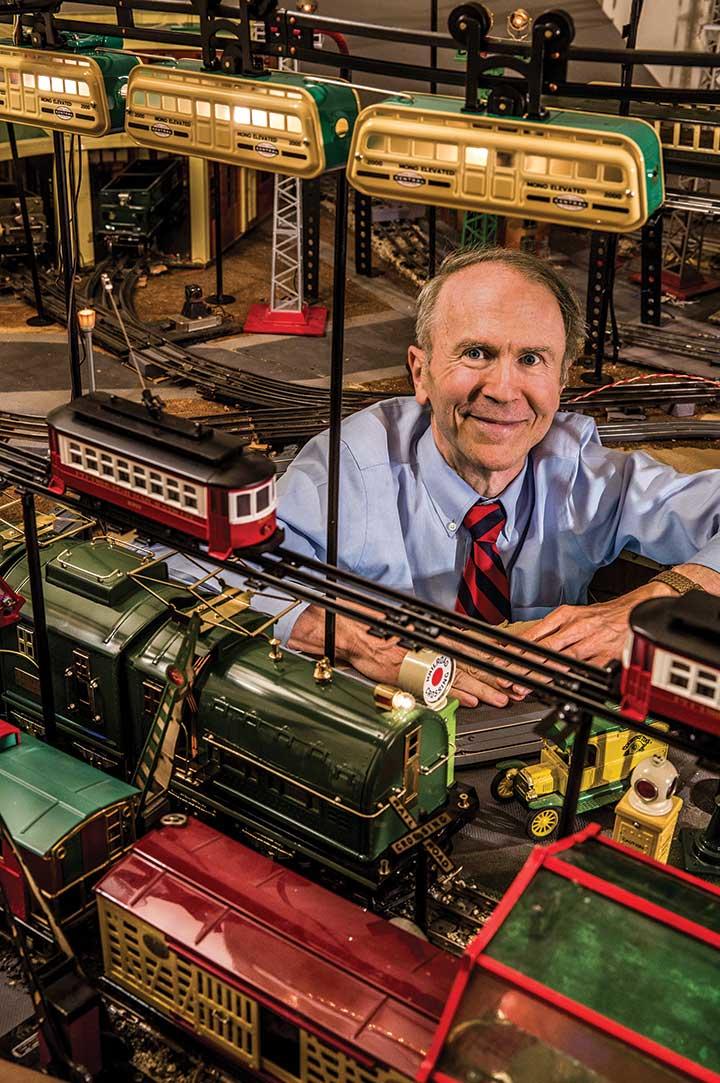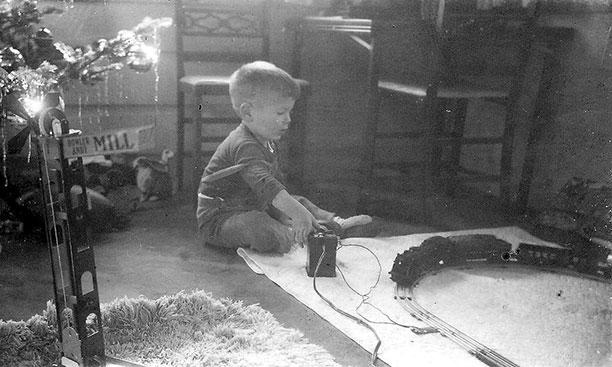Bruce Greenberg ’65 Shares His Love of Model Trains
In 1967, Bruce Greenberg ’65, a political science graduate student at the University of Michigan, saw a small classified ad in a local newspaper that would change his life: “Toy trains for sale … ” Greenberg hadn’t thought about his elaborate childhood model train set in some time, but he was curious. He and his future wife Linda went to have a look, and his fascination was rekindled. The toy trains of Greenberg’s midcentury youth had been realistic, often bearing the same paint colors and names as the trains he might see on the railroad in his hometown of Collingswood, N.J. So he was awestruck when he saw an array of Lionel’s earlier, more flashy models from the 1920s and ’30s.
“There was a whole world of trains before World War II: I saw an engine that looked like a highly interpretive model of an electric locomotive … and was painted peacock blue,” he said. “This marvelous piece of steel resembled something like a real [train] but nothing that would ever appear on a real railroad. How did these things change over time?”
Greenberg wound up with a $30 train set after that day, but seeing all of the trains together — the realistic midcentury locomotives juxtaposed with earlier, brightly colored cars festooned in brass — had reignited his fascination with the objects. As a Ph.D. student, his intellectual curiosity kicked in. But in seeking out more information, his first lesson was in the scarcity of toy-train literature. Greenberg quickly discovered that Lionel’s annual catalogs were the best source documents — each charting the singular taxonomy of that year’s model. Together, the catalogs would constitute a sort of evolutionary visual dictionary for the world’s most famous toy train.“The catalogs at that time, let’s say a 1931, would be $60 in beaten-up condition. Well, I could buy a very fine set of 1931 trains for $60 in 1968, so although I’d like to have the information, I’d rather have the trains,” he said. (It must be noted that when Greenberg discusses toy trains, his excitement quite infectiously mounts, denoted henceforth with exclamation points.) “I eventually solved that problem, and it only took me a couple of years!”
By then Greenberg was working as college administrator. One day, a train-collecting friend called and entreated him to come over as soon as possible. “Of course, I dropped what I was doing, and I got there!” he said.
To his awe and delight, he was shown two newly acquired Lionel catalogs. Greenberg discovered their contents belonged in the public domain, so he took the catalogs to the college print shop and had copies made.
“I figured there must be at least 100 other people who would be as interested in this as I am,” he said. “My hunch was right! People found my $2 price irresistible!”
Greenberg’s publications gained momentum until finally, in 1975, he discovered his income from the toy-train books was equal to his salary. He left his job to publish full time, and began larger print runs for the source material he’d discovered in catalogs and manuals. He next began to reorganize the information from the catalogs to help readers understand the year-to-year changes of each train model with anatomical precision. He also began to incorporate a pricing guide — an undertaking that was as challenging politically as it was logistically.
“I found people who were active buyers and sellers, and I had to persuade them that by helping set the prices, they were really expanding the hobby by giving people information that’s reliable, so they feel more comfortable in buying and in selling,” he said.
In the days before the internet, selling his toy-train books was an unwieldy undertaking, requiring up to 20 weekends on the road throughout the East Coast to hawk his goods at train events in places like local Knights of Columbus halls with perhaps 200 “very eager” enthusiasts filtering through.
Greenberg began to puzzle: If so many small events with next to no publicity could consistently draw a crowd, what would a one, giant, well-publicized show look like?
“In 1976, I said we’re going to do it differently. The nearest large hall was the Ellicott City [Md.] Armory. It was 9,000 square feet — much larger than had ever been done before,” he said.
“I realized the show was made to order for television! Why? I had moving objects that make sounds, that blow smoke, and I had people wearing funny hats! And children! I called each of the Baltimore TV stations and two showed up. One of them had an anchor who loved toy trains, and he wore a railroad hat too!”
Such were the beginnings of the Greenberg’s Great Train Shows, which endure today, as Greenberg’s Great Train and Dollhouse Show (the latter was added in 1980 to attract more girls and women).
Greenberg, who has written at least 24 books on toy-trains, has sold his publishing company and the rights to the shows, but he still cranks out self-published toy-train guides with titles such as Greenberg’s Guide to Lionel Trains: O Gauge, Volume 1: 1915-1928. Inside the 423-page book, readers will find an exhaustive exploration of each of Lionel’s O-Gauge trains for the specified era, as well as a few pages of acknowledgment of Greenberg’s many collaborators, who lend him everything from pricing advice to toy-trains for photography. The introduction features an all-caps warning to novices against major purchases without expert guidance and Greenberg’s home phone number for collectors’ insights.
“My emotional connection stems from that childhood passion for Lionel trains and my pleasure in building a model railroad,” Greenberg said. “I was taking pieces and putting them together to form something that worked and was pleasing to the eye. So when I started to add grass, and plastic buildings, and little trees, and little people, I was creating a miniature world! The notion of being able to create a world in miniature was — is! — really so pleasurable.”













1 Response
Henry Joseph
6 Years AgoUsing One's Degree
A very healthy use of a political science degree.